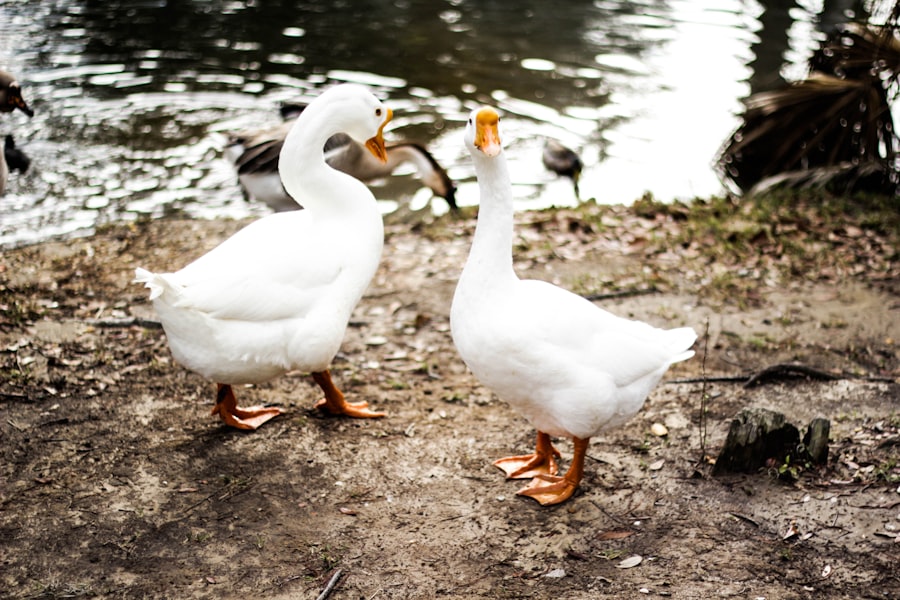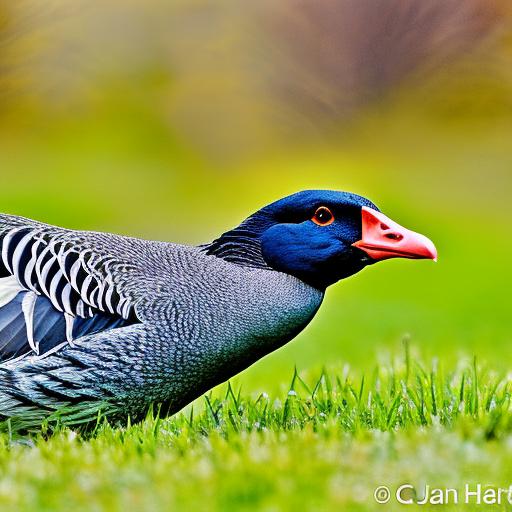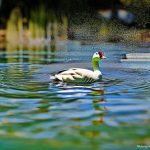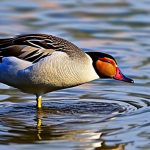Geese are fascinating creatures with complex social behaviors. They are highly social animals and are known for their strong family bonds. Geese are also very territorial and will defend their nesting and feeding areas aggressively. They are known to be monogamous and will often return to the same nesting site year after year. Geese are also migratory birds, and they will travel long distances to find suitable nesting and feeding grounds. They are herbivores and primarily feed on grass, aquatic plants, and grains. Geese are also known for their distinctive honking calls, which they use to communicate with each other.
Geese are also known for their aggressive behavior, especially during the breeding season. They can become quite territorial and may attack humans or other animals that they perceive as a threat to their nesting area. It’s important to understand these behaviors when considering geese control measures. By understanding their behavior, it becomes easier to implement effective strategies for managing geese populations in urban and suburban areas.
Geese are also highly adaptable birds and can thrive in a variety of environments, including parks, golf courses, and residential neighborhoods. They are attracted to areas with open water, lush grass, and minimal disturbance, making urban and suburban areas ideal habitats for them. Understanding these behaviors can help in developing effective geese management strategies that take into account their natural tendencies and behaviors.
Key Takeaways
- Geese are social birds that exhibit strong family bonds and are highly territorial, especially during nesting season.
- Natural repellents such as citrus sprays, predator decoys, and reflective objects can help deter geese from frequenting a specific area.
- Installing physical barriers like fences, hedges, or netting can effectively prevent geese from accessing and damaging lawns and gardens.
- Professional services such as habitat modification, egg addling, and humane trapping can provide long-term solutions for geese control.
- It is important to be aware of local and federal laws regarding geese management, including permits for certain control methods and protection of migratory bird species.
- Engaging the community in geese control efforts through education, cooperation, and responsible feeding practices can help reduce the impact of geese in public spaces.
- Long-term strategies for geese deterrence include habitat modification, landscape design, and consistent maintenance to discourage geese from nesting and foraging in specific areas.
Natural Repellents for Geese
When it comes to managing geese populations, natural repellents can be an effective and environmentally friendly option. There are several natural substances that can be used to deter geese from congregating in specific areas. One common natural repellent is grape seed extract, which is known to irritate the digestive system of geese when ingested. This can discourage them from feeding in treated areas. Another natural repellent is methyl anthranilate, a substance derived from grape juice, which is used to create a non-toxic bird repellent. This substance irritates the birds’ trigeminal nerves, causing them to avoid treated areas.
In addition to these natural repellents, there are also physical barriers that can be used to deter geese from specific areas. These include reflective tape, scarecrows, and predator decoys, which can create a sense of danger for the geese and discourage them from settling in a particular location. Natural landscaping features such as tall grasses, shrubs, and hedges can also create barriers that make it difficult for geese to access certain areas. By using a combination of natural repellents and physical barriers, it is possible to effectively manage geese populations without resorting to harmful chemicals or aggressive tactics.
Physical Barriers to Keep Geese Off Lawn
Physical barriers can be an effective way to keep geese off lawns and other areas where they are not welcome. One common physical barrier is a fence or netting that can be installed around the perimeter of the area to be protected. This can prevent geese from accessing the area and can be an effective long-term solution for keeping them at bay. Another physical barrier option is the use of floating barriers on bodies of water, such as ponds or lakes, to prevent geese from congregating in these areas.
In addition to fences and floating barriers, there are also natural landscaping features that can act as physical barriers to keep geese off lawns. Tall grasses, shrubs, and hedges can create obstacles that make it difficult for geese to access certain areas. These natural barriers can be aesthetically pleasing and can also provide habitat for other wildlife species. By combining physical barriers with natural landscaping features, it is possible to create an environment that is less attractive to geese and discourages them from settling in specific areas.
It’s important to consider the specific needs of the area when choosing physical barriers for geese control. Factors such as the size of the area, the presence of water features, and the surrounding landscape should all be taken into account when developing a physical barrier strategy. By carefully considering these factors, it is possible to create an effective and sustainable solution for keeping geese off lawns and other areas where they are not wanted.
Professional Services for Geese Control
For those who are dealing with persistent geese problems, professional services for geese control can be a valuable resource. There are companies that specialize in geese management and offer a range of services to help property owners effectively manage geese populations. These services may include habitat modification, such as the installation of physical barriers or the implementation of natural landscaping features that deter geese from settling in specific areas. Professional services may also include the use of non-lethal deterrents, such as sound devices or visual deterrents, to discourage geese from congregating in certain locations.
In addition to habitat modification and deterrents, professional services for geese control may also include population management strategies. This can include the use of egg addling techniques, which involve shaking or coating goose eggs to prevent them from hatching. This can be an effective way to reduce the local geese population without causing harm to the birds. Professional services may also include the use of trained dogs to discourage geese from settling in specific areas, as well as the implementation of hazing programs that use non-lethal methods to encourage geese to move on to more suitable habitats.
When considering professional services for geese control, it’s important to choose a reputable company with experience in managing geese populations in urban and suburban areas. By working with professionals who understand the behavior and habits of geese, property owners can develop effective strategies for managing geese populations without causing harm to the birds or the environment.
Legal Considerations for Geese Management
When it comes to managing geese populations, there are legal considerations that property owners must take into account. In many areas, geese are protected under wildlife conservation laws, which means that certain management strategies may be restricted or prohibited. It’s important to familiarize oneself with local wildlife regulations before implementing any geese control measures to ensure compliance with the law.
One common legal consideration for geese management is related to nesting season. In many regions, disturbing active goose nests or eggs is prohibited by law. This means that property owners must be mindful of nesting season when implementing management strategies and may need to seek professional guidance to ensure compliance with wildlife regulations. Additionally, some regions have specific regulations regarding the use of deterrents or population management techniques for geese, so it’s important to research local laws before taking action.
In some cases, property owners may need to obtain permits or permissions from wildlife authorities before implementing certain geese control measures. This can include permits for egg addling or population management programs that require professional assistance. By understanding the legal considerations for geese management and seeking guidance from wildlife authorities when necessary, property owners can ensure that they are managing geese populations in a legal and responsible manner.
Community Involvement in Geese Control

Community involvement can be a valuable asset when it comes to managing geese populations in urban and suburban areas. By working together with neighbors, local organizations, and government agencies, property owners can develop effective strategies for controlling geese populations that benefit the entire community. One way to involve the community in geese control is through education and outreach programs that raise awareness about the behavior of geese and the importance of responsible management strategies.
Community involvement can also take the form of collaborative efforts to implement habitat modification and deterrents that discourage geese from settling in specific areas. By working together with neighbors and local organizations, property owners can create a unified approach to managing geese populations that is more effective than individual efforts. This can include the installation of physical barriers around shared spaces, such as parks or community ponds, as well as the implementation of natural landscaping features that make these areas less attractive to geese.
In addition to collaborative efforts for habitat modification and deterrents, community involvement in geese control can also include volunteer programs for population management strategies. This can involve community members participating in egg addling programs or hazing efforts that encourage geese to move on to more suitable habitats. By involving the community in these efforts, property owners can create a sense of shared responsibility for managing geese populations and develop sustainable solutions that benefit everyone.
Long-Term Strategies for Geese Deterrence
When it comes to managing geese populations in urban and suburban areas, long-term strategies for deterrence are essential for sustainable results. One long-term strategy is habitat modification, which involves creating an environment that is less attractive to geese by implementing physical barriers and natural landscaping features that discourage them from settling in specific areas. This can include the installation of fences or netting around bodies of water, as well as the planting of tall grasses, shrubs, and hedges that create obstacles for geese.
Another long-term strategy for geese deterrence is the use of non-lethal deterrents that discourage geese from congregating in specific locations. This can include sound devices or visual deterrents that create a sense of danger for the birds and encourage them to move on to more suitable habitats. By implementing these non-lethal deterrents on a long-term basis, property owners can create an environment that is less attractive to geese without causing harm to the birds or the environment.
In addition to habitat modification and non-lethal deterrents, long-term strategies for geese deterrence may also include population management techniques such as egg addling programs or hazing efforts that encourage geese to move on to more suitable habitats. By combining these long-term strategies with community involvement and professional services when necessary, property owners can develop effective and sustainable solutions for managing geese populations in urban and suburban areas.
In addition to habitat modification and non-lethal deterrents, long-term strategies for geese deterrence may also include population management techniques such as egg addling programs or hazing efforts that encourage geese to move on to more suitable habitats. Egg addling involves shaking, puncturing, or coating goose eggs to prevent them from hatching, thus reducing the population over time. Hazing efforts can include using trained dogs, noise makers, or other methods to make the area less appealing to geese. By combining these long-term strategies with community involvement and professional services when necessary, property owners can develop effective and sustainable solutions for managing geese populations in urban and suburban areas. This comprehensive approach can help minimize conflicts between humans and geese while promoting the well-being of both.
If you’re looking for effective ways to keep geese off your lawn in Columbus, Ohio, you might be interested in learning about the benefits of using a chicken coop trampoline. This innovative solution not only keeps chickens safe and happy but can also help deter geese from invading your property. To find out more about this unique approach, check out the article on PoultryWizard.
FAQs
What are some effective methods to keep geese off my lawn in Columbus, Ohio?
Some effective methods to keep geese off your lawn in Columbus, Ohio include installing physical barriers such as fences or netting, using repellents such as motion-activated sprinklers or reflective tape, and employing landscaping techniques to make the area less attractive to geese.
Are there any local regulations or laws regarding geese control in Columbus, Ohio?
In Columbus, Ohio, there may be local regulations or laws regarding the control of geese, especially if they are considered a nuisance or pose a threat to public health and safety. It is advisable to check with local authorities or wildlife management agencies for any specific guidelines or restrictions.
What are the potential risks associated with geese on my lawn in Columbus, Ohio?
Geese on your lawn in Columbus, Ohio can pose risks such as property damage, health hazards from droppings, and aggressive behavior, especially during nesting season. It is important to address the presence of geese to mitigate these potential risks.
How can I deter geese from nesting on my lawn in Columbus, Ohio?
To deter geese from nesting on your lawn in Columbus, Ohio, you can use techniques such as disrupting their habitat by mowing the grass regularly, removing potential nesting materials, and using visual deterrents such as decoys or scare devices.
What are some environmentally friendly methods to keep geese off my lawn in Columbus, Ohio?
Some environmentally friendly methods to keep geese off your lawn in Columbus, Ohio include using natural repellents such as citrus-based sprays, planting goose-resistant vegetation, and creating alternative habitat areas to attract geese away from your lawn.
Meet Walter, the feathered-friend fanatic of Florida! Nestled in the sunshine state, Walter struts through life with his feathered companions, clucking his way to happiness. With a coop that’s fancier than a five-star hotel, he’s the Don Juan of the chicken world. When he’s not teaching his hens to do the cha-cha, you’ll find him in a heated debate with his prized rooster, Sir Clucks-a-Lot. Walter’s poultry passion is no yolk; he’s the sunny-side-up guy you never knew you needed in your flock of friends!







